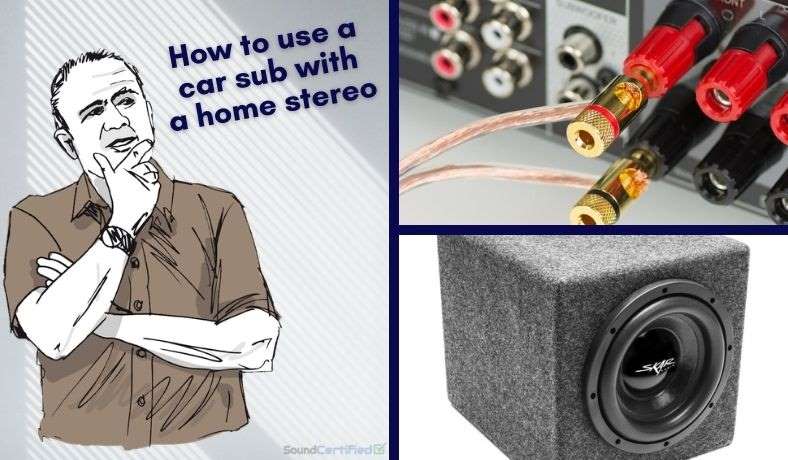Thinking about putting that extra car sub to good use? Maybe you’re wondering if it’s possible to hook up a car subwoofer to a home stereo or amplifier at all.
The good news is that yes, in many cases you can use a car sub with a home stereo. However, it’s not as easy as just wiring them up any old way.
I’ll tell you what you need to know and provide some helpful diagrams. Let’s get started.
Contents
Can I hook up a car subwoofer to my home stereo?
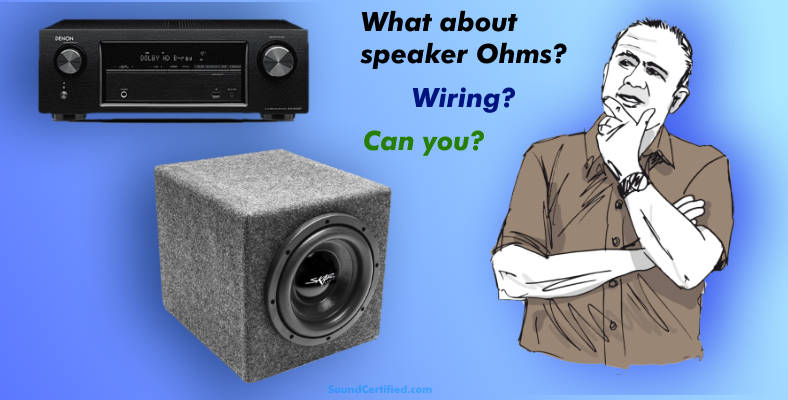
The quick answer is that it depends. There are several basic things you need to understand first before you try. These are important, too…so don’t be careless or you could damage your home receiver or amplifier.
You can hook up a car subwoofer to a home stereo directly if:
- You have a subwoofer or more than one subwoofer that can be wired for at least 8 ohms total. This can be two 4 ohm subwoofers or a 4 ohm dual voice coil (DVC) subwoofer. [See diagrams below for how]
- Your home stereo or amp can handle 4 ohm speakers (most can’t so let’s ignore this).
- Using workarounds: this includes using a small 4-ohm capable amp between the receiver and sub or an inline resistor to bring up the speaker load. (Don’t worry – I’ll share these in detail below)
Even if you have the right car subwoofer(s) your amp needs to have enough power available to drive the subwoofer box. The good news is that for casual listening you don’t need a ton of power like you do for cars and truck use.
The single biggest obstacle is that most home stereos, home theater receivers, and home amplifiers can’t handle the 4 ohm speaker load of many car subwoofers. It’s 2x lower than the 8 Ohm minimum most require. (Some car subwoofers are even 2 ohms, in fact).
Why can’t I use a 4 or 2 ohm car subwoofer with a home stereo?
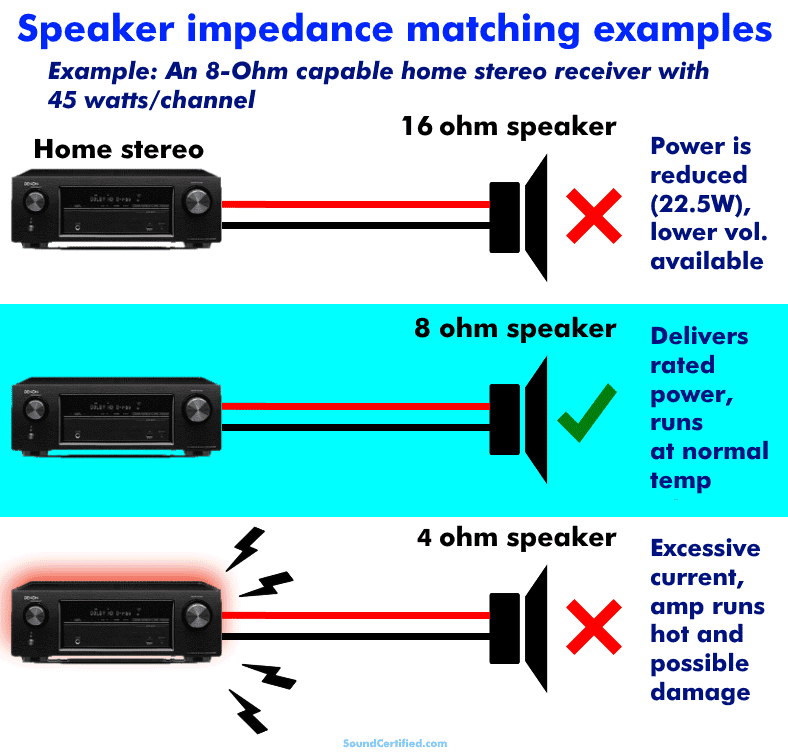
You’ll need to be sure to avoid connecting a speaker impedance (Ohms, speaker load) that’s too low to a home stereo amp or receiver. Doing so causes it to try to produce more electrical current than it’s designed for. This causes overheating and potentially permanent damage to your electronics.
Just like car amplifiers & car stereos, home stereos have a minimum speaker load, stated in Ohms, that they’re designed to handle.
Never try connecting 2 or 4 ohm subwoofers or speakers to a home stereo – they’re likely to overheat very quickly and suffer possible damage.
Why is matching speaker impedance important?
Matching the speaker load to your home stereo just means matching it up with the best Ohm load that will deliver the power & volume it’s designed to produce. As you can see in my diagram above, if the speaker is over the rated Ohm spec, it will work safely but at the expense of delivering a lot less power and volume than you’d like.
Using the correct Ohm load means you’ll get the rated power – and as you might guess – the maximum volume possible.
However, using less than the rated Ohm speaker load (whether 1 or more speakers, the total Ohm load the stereo sees) is dangerous and won’t work. Don’t do it!
Do I need a speaker crossover for a car subwoofer?
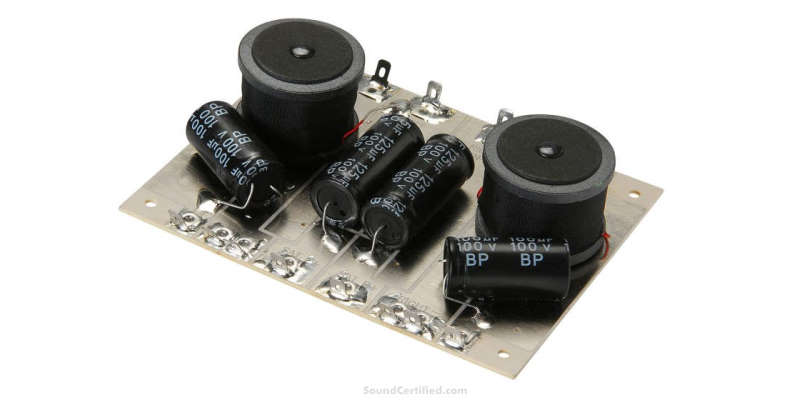
Example of an 8-Ohm compatible low-pass speaker crossover for blocking all sounds above a low bass frequency (cutoff frequency). These are used to get “clean” sounding bass from a subwoofer when there’s no crossover already provided.
By the way, there’s another important part you’re likely to need and may not have thought about: using a speaker crossover for clear bass with a car subwoofer. Car subwoofers are normally used with a car amp with a low-pass crossover built in already.
That’s often not the case for home stereos, although some do have a subwoofer RCA output jack for use with an amplifier or powered subwoofer.
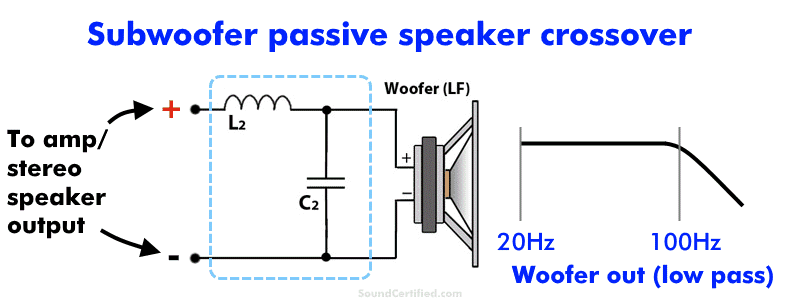
The point is that unless you want to hear vocals and other sounds from the car subwoofer, you’ll need to hook up a subwoofer speaker crossover between the stereo & the sub. For clear bass, you’ll need a crossover to block higher-frequency sounds subs can’t play well.
If you’re lucky enough to own a receiver or home amp with a low-pass crossover built in you can use that instead.
How to wire a car subwoofer to a home stereo

As you can see from my diagram above, I’ve come up with 4 ways to connect a car stereo to your home stereo receiver or amp – but it greatly depends on the specifics. For example, using a 4 ohm car sub is relatively simple, while using a 2 ohm or another type can be more complicated.
Here are the 4 ways you can do this:
- Two 4 ohm car subwoofers: This is one of the simplest setups possible. Just connect the subs in series for a total of 8 ohms and connect them to one of the stereo receiver speaker outputs. However, be aware that if there’s no speaker crossover in place or built-in, you’ll get vocals and sounds in the subs that won’t sound good, so a crossover may be needed. (see above)
- Single DVC 4 ohm subwoofer: Likewise, a single dual voice coil (DVC) subwoofer with 4 ohm windings can be wired in series to meet the 8 ohm requirement. Just like above, a low-pass (subwoofer) crossover may be needed.
- Single 4 ohm subwoofer or receivers without enough power – using a mini amp: You can use an affordable miniature amp to drive a 4 ohm car sub directly, avoiding the needed to lose power like you would in option #4. You can use a mini amp that can drive a 4 ohm or even 2 ohm car sub directly. Some also have a built-in crossover for great sound making them a great choice.
- Single 4 ohm subwoofer using a series power resistor: This is the simplest and most affordable option. Using a power resistor (a resistor that’s designed to handle higher power levels) just wire it in series with the sub to get the 8 ohms needed. Power resistors can be found for around $5 more or less. I recommend a 25 watt or higher rating, depending on your stereo’s power output.
Note that while option #4 is the easiest of all, I don’t recommend it because you’ll lose 1/2 or more of the stereo’s power output. That’s because the power is divided between it and the sub.

Examples of power resistors you can use for speaker projects including hooking up a sub to a home stereo. These resistors can be found and electronic parts stores and speaker part retailers, or even Amazon or eBay. They’re often priced very affordably (around $5 or so for a pair or pack).
What to do if you can’t get the right Ohms together
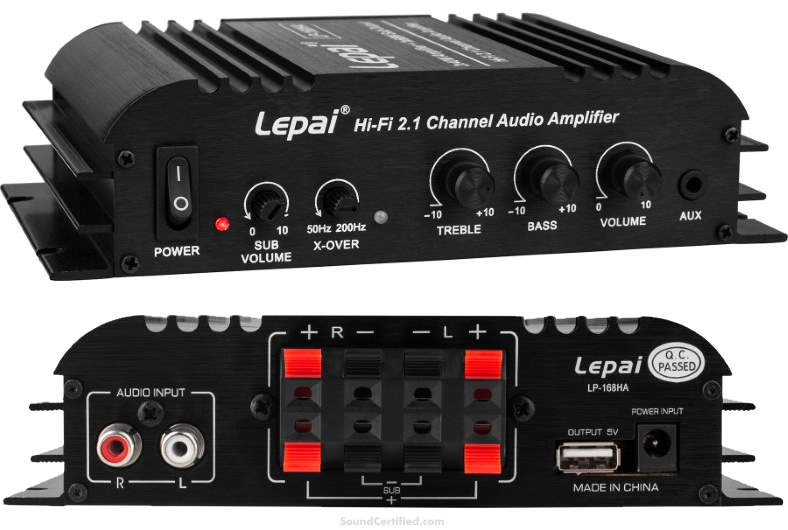
Example of a small & affordable amplifier that can be used to drive a lower impedance car subwoofer from your home stereo receiver. You can find these with a crossover built-in (as shown here) for under $30.
It’s a bit tricky in some cases – especially when using multiple car subwoofers and/or those like 2 ohm models, for example. A home stereo amp is a great answer to this problem and offers several benefits:
- Can drive lower impedance subs directly
- Low cost (often under $30) and very compact size
- Some include a low pass crossover built in meaning you’ll save a lot of hassle
While I realize you might not want to have to spend money & wait for the stuff to arrive, it’s definitely worth thinking about. Here’s a good example of an inexpensive one I found.
How do you hook up a subwoofer to a receiver without sub output?
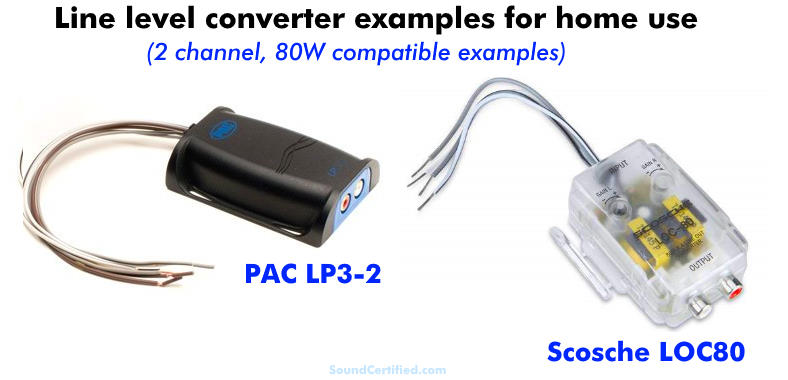
Examples of line level converters use you can use to get an RCA low-level signal from a home stereo without subwoofer RCA outputs.
The good news that if you’re planning to use a small amp to power a sub at home but your receiver doesn’t have a subwoofer or other RCA outputs there’s a solution. You can use a line level converter, commonly used for factory-installed car stereos, to create some, then connect to a subwoofer amp.
You’ll want a good quality one with adjustable output level dials to be sure you don’t have problems with the signal level. They’re especially valuable to have as many vintage or older home stereos don’t have subwoofer outputs.
You can connect them just like you would a speaker, either to unused speaker outputs or also connect them alongside speakers already in use.
How many watts do you need for a subwoofer?
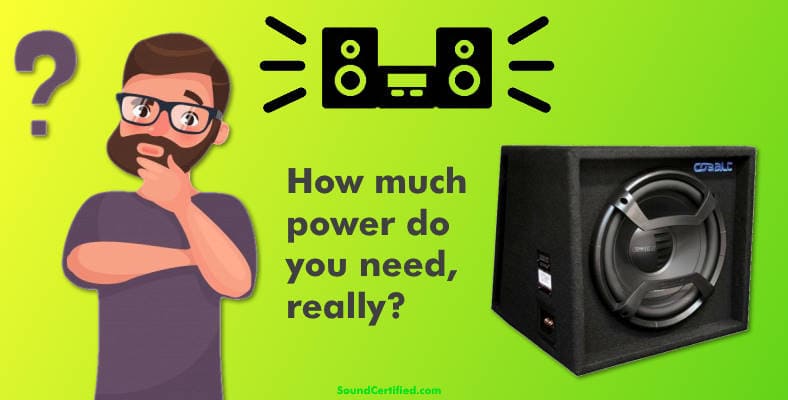
Car subwoofers are very inefficient speakers and are some of the most power-hungry you can find! The good news is that if you’re just looking forward to average listening levels you can get by with less power.
- For easy listening, low-volume music levels, or sound from movies, you’d want at least 25 watts RMS of power per channel available to drive a subwoofer.
- For a bit more “punch” that requires extra bass (especially the bass & thuds from DVD or BlueRay video sound) 50W+ would be much better.
If your home receiver is on the weaker side as some budget models are (for example, 15W-20W per channel) you’ll need a small external amp as I mentioned earlier. If you’re planning driving a car subwoofer with high volume and want some serious bass I’d recommend a minimum of 100W RMS and even more if you can afford it.
Bookshelf stereos usually can’t cut it – they’re just not designed to produce much power. However many decent quality home stereo receivers or home theater amps/decoders can do the job ok.
Home stereos vs car amplifiers
On the downside, home stereos don’t produce anywhere near the power of today’s car amps which typically have at least 75W to 100W or more per channel, if not several times that! On the plus side, when using a subwoofer inside your home you don’t have the terrible acoustical losses that you do in a car or truck.
This means when using a car subwoofer inside your home you need less power to hear it well.
Subwoofer sensitivity (efficiency) & volume
Some subwoofers produce more volume for the same amount of power. This is actually a standard specification used to compare speakers and the official name is speaker sensitivity. In other words, the sensitivity of a speaker describes the volume output it produces for a given amount of power, in decibels (dB).
A standard dB reading of 1 watt measured 1 meter (1M) away is used for this measurement in the speaker industry.
When comparing two subwoofers, for example, one might have a sensitivity of 87dB/W while a 2nd one has one of 91dB/W. This means the second produces more sound with less power. Because speakers require a doubling of power to increase another 3dB in volume, that means a more efficient speaker can use 1/2 the power or less than another speaker for the same volume!
That’s something to think about when comparing subs.
Will a sub work without an amp?
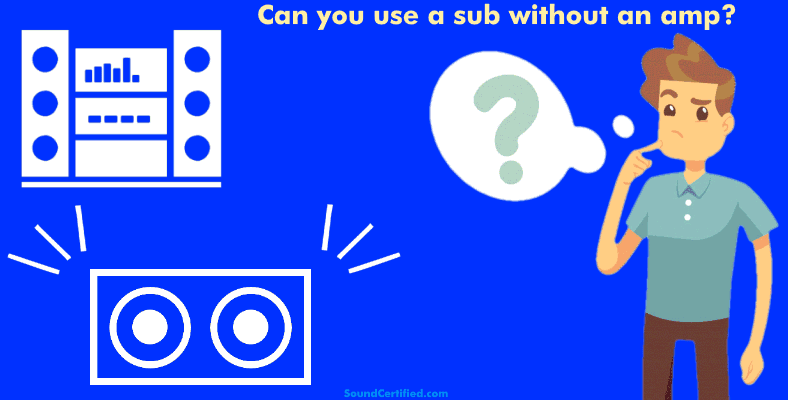
This one’s easy to answer, although it’s important to be clear about power & amplifiers. In general terms, no, a sub won’t work ok without an amp.
Hang on a second, though! What does “amp” mean in that case? To be more clear, here’s the long and short of it:
- A subwoofer, like any other speaker, must be powered by an amplified audio signal with a decent amount of wattage in order to produce sound.
- To properly drive a subwoofer for it to work well, that’s different; in that case, yes, without question you need an amplifier of sufficient power to drive it well.
That is to say, you can’t hook up a subwoofer to a non-amplified signal output from any stereo or other audio source. You need an amplified speaker output with a fair amount of power in order for it to work ok and sound right.
As I mentioned earlier, for casual listening inside your home you can likely get away with 25 watts for subwoofers with decent efficiency. However, if you want to drive a subwoofer hard and get that real bass “thump”, you’ll need a lot more power: 80-100W or more for a home amplifier.
